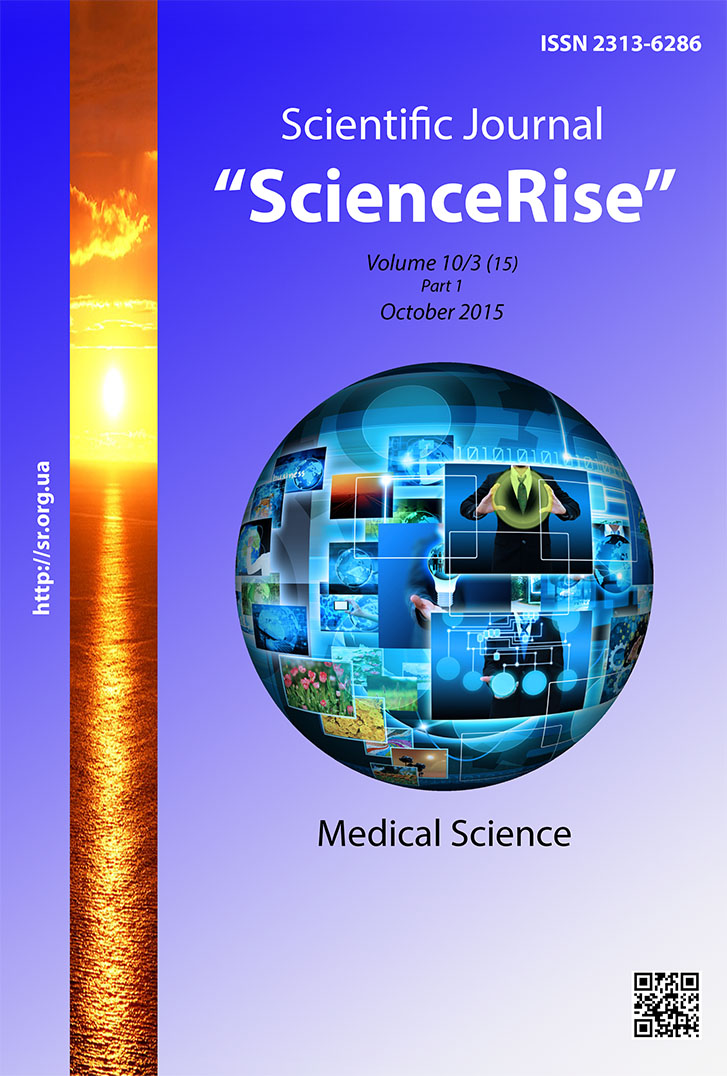The definition of indices for bed stock optimization in medical institutions of hospital district
DOI:
https://doi.org/10.15587/2313-8416.2015.51925Keywords:
bed stock, stationary care, hospital district, hospitalization reasonableness, treatment durationAbstract
Introduction: Reformation of health protection sphere in Ukraine is impossible without optimization of stationary care with rational and open approach to estimation of the necessary bed stock what is particularly actually at hospital districts creation.
Aim: to define factors of ungrounded hospitalization and possible decrease of treatment duration of patients who underwent stationary care in relevant departments.
Methods: In research there were used 615 medical records of stationary patients (form 003/о) from Zhitomir region who finished their treatment in 2013. Medical documentation was selected by the way of total sample. At the first stage there was assessed the reasonableness of hospitalization in points from 0 (absolutely absent) to 5 (absolutely present). At the second one there was carried out retrospective analysis of patients medical records on optimal treatment duration by an expert assessment of medical records of patients whose hospitalization was grounded. Among 615 medical records that were used at the previous stage 399 were selected. On every medical record expert defined the number of days of the possible decrease of the hospital stay duration without an effect on patient’s state and final result of treatment.
Results: On the results of first stage there were established that the mean index of ungrounded hospitalization was 35,1±1,9 %. On the results of second stage of research there were established that the mean duration of round-the-clock hospital departments stay was 8,25±0,98 days and was revealed a possibility to decrease this index by 0,70±0,02 bed-days.
Conclusions: At hospital districts creation it is necessary to define indices of treatment duration and hospitalization reasonableness for patients in health protection institutions that are planned to be included to the one hospital district and to take it into account at calculation of profiles and number of beds
References
Lekhan, V. M., Slabkyj, H. O., Shevchenko, M. V. (2010). Stratehiia rozvytku systemy okhorony zdorov'ia: ukrains'kyj vymir [The development strategy of the health system: Ukrainian dimension]. Chief doctor, 1, 20–36.
Holiachenko, O. M., Panchyshyn, N. Y., Smirnova, V. L. (2010). Novi pidkhody do reformuvannia statsionarnoi dopomohy [New approaches to reform hospital care]. Journal of Social Hygiene and Public Health Organization Ukraine, 1, 34–37.
Slabkyj, H. A., Shevchenko, M. V., Zozulia, A. Y. (2012). Hospytal'nye okruha: real'nost' y rysky ykh sozdanyia [Hospital Districts: reality and risks deal with their creation]. Ukraine. Health of nation, 3 (23), 261–265.
Hinzburh, V. H. (2010). Strukturna perebudova systemy okhorony zdorov'ia na rehional'nomu rivni: dosiahnennia ta zavdannia [The restructuring of the health system at the regional level: achievements and objectives]. Medical prospects, 4, 137–143.
Slabkyj, H. O., Zbitneva, S. V. (2012). Kharakterystyka vykorystannia lizhkovoho fondu dlia statsionarnoho likuvannia dorosloho naselennia z khvorobamy orhana zoru [Description of the use of hospital beds for hospital treatment of adults with diseases of eye]. Ukrainian Medical Journal, 6 (92), 100–102.
Vuiv, O. H. (2007). Problemy vyznachennia ekonomichnoi ta medychnoi efektyvnosti statsionarnoi dopomohy ta vykorystannia lizhkovoho fondu v suchasnykh umovakh (ohliad naukovoi literatury) [Current problems in determining the economic and medical efficiency of in patient health care and the usage of hospital beds (review of published data)]. Ukrainian Medical Journal, 4 (60), 9–14.
Diachuk, D. D. (2012). Otsinka pidkhodiv do rozrobky ta vykorystannia innovatsijnykh modelej udoskonalennia diial'nosti zakladiv okhorony zdorov'ia [Assessment of approaches to the development and use of innovative models improvement of health facilities]. Journal of Social Hygiene and Public Health Organization Ukraine, 3, 75–85.
Andriievs'kyj, I. Y. (2014). Tsentyl'nyj metod obhruntuvannia lizhkovoho fondu pry formuvanni hospital'noho okruhu [Centile method of substantiation bed fund in hospital district forming]. Journal of Social Hygiene and Public Health Organization Ukraine, 1, 48–53.
Lekhan, V. M., Pavlenko, M. V., Volchek, V. V., Lytvynov, O. A. (2012). Avtomatyzatsiia planuvannia resursiv statsionariv [Automation hospital resourse planning]. Ukr.z.telemed.med.telemat, 10 (2), 13–17.
Krempels, K. H., Panchenko, A. (2006). An Approach for Automated Surgery Scheduling. Practice and Theory of Automated Timetabling. Czech Republic, 123–127.
Downloads
Published
Issue
Section
License
Copyright (c) 2015 Сергій Миколайович Грищук, Валентин Дмитрович Парій, Василь Миколайович Борис

This work is licensed under a Creative Commons Attribution 4.0 International License.
Our journal abides by the Creative Commons CC BY copyright rights and permissions for open access journals.
Authors, who are published in this journal, agree to the following conditions:
1. The authors reserve the right to authorship of the work and pass the first publication right of this work to the journal under the terms of a Creative Commons CC BY, which allows others to freely distribute the published research with the obligatory reference to the authors of the original work and the first publication of the work in this journal.
2. The authors have the right to conclude separate supplement agreements that relate to non-exclusive work distribution in the form in which it has been published by the journal (for example, to upload the work to the online storage of the journal or publish it as part of a monograph), provided that the reference to the first publication of the work in this journal is included.

